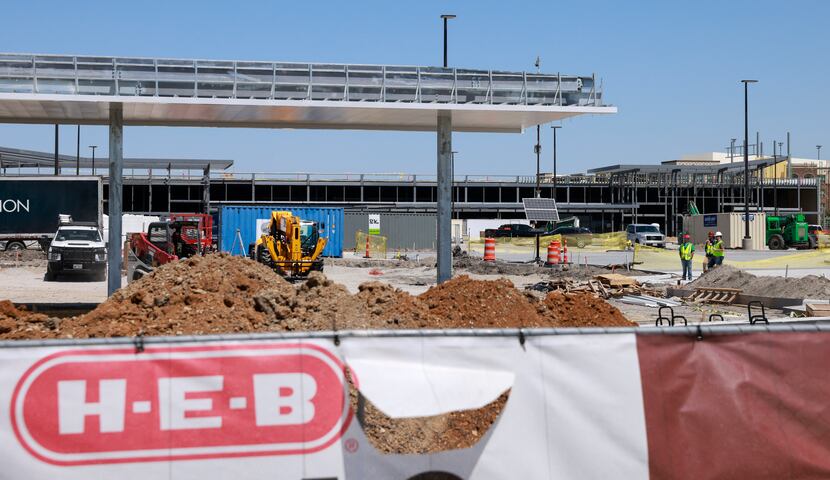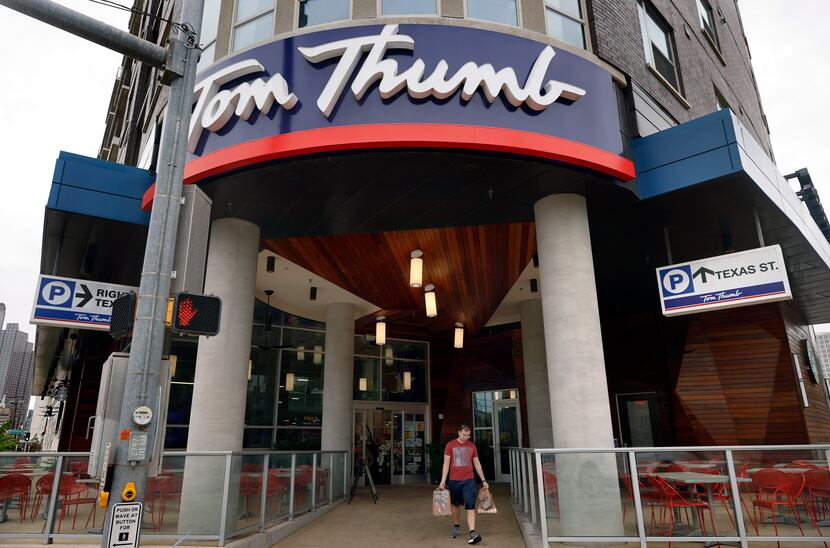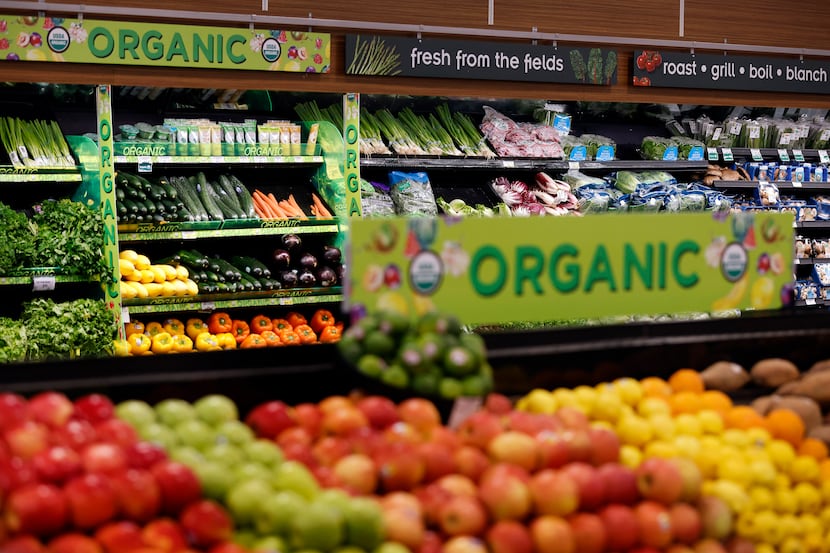Dallas-Fort Worth grocery shopping is going to be the best it’s ever been in 2022, especially if you live in Collin County. Saying that isn’t going out on a limb.
The race for more than $24 billion in annual grocery spending is intensifying, and experts say the winner will be the consumer.
D-FW’s grocery chains have spent the past year planning how to defend their turf, shoring up their market share and trying to earn more shopper loyalty before Texas grocer H-E-B opens its first big new stores in Frisco and Plano later this year. H-E-B, which also owns Dallas-based Central Market, will open in McKinney next year, then Melissa, Mansfield, Forney, Dallas and so on.
“Consumers are in for a great cycle,” said Bob Young, executive managing director at commercial retail real estate firm Weitzman, which is among the top three operators of grocery-anchored shopping centers in D-FW.

“Someone that’s strong and considered ahead of the class coming into the market will make all grocery shopping better,” Young said.
A year ago, San Antonio-based H-E-B said it was making its long-anticipated entrance into the market just as grocers were dealing with the second year of the pandemic, which included responding to customers’ shifting shopping behaviors, maneuvering supply chain issues and raising wages to help alleviate labor shortages.

New store plans
After a multiyear pause in construction, some major grocers say they’re ready to start building stores again.
- Kroger is planning a new store in Melissa and said it will replace one of its Plano stores when a new one is built.
- Whole Foods Market will anchor the retail section of a 50-acre mixed-use apartment and office project called West Grove at the southeast corner of Custer Road and U.S. Highway 380 in McKinney.
- Target, which has been busy remodeling its local stores but hasn’t opened a new one in the market since 2018, is building a 140,000-square-foot store on U.S. Highway 380 and Preston Road in Prosper.
- Oak Cliff’s Wynnewood Village Kroger store is being remodeled.
- Kroger’s new store at Hall and Flora streets just east of downtown Dallas is under construction.
- Trader Joe’s is looking for new sites again.
- Sprouts Farmers Market, which just opened stores in Grand Prairie and Las Colinas, will open in September in East Dallas’ Hillside Village in a space that had been a Stein Mart.
- Albertsons is opening in south Irving after a 15-year absence when it completes an extensive remodel of a former Fiesta Mart.
“Operating in D-FW means that you are operating in the No. 1 fastest-growing market in the U.S. — and you can’t operate in a market like that and not have plans to look for opportunities to open new locations,” said Wes Jackson, president of Albertsons Cos.’ southern division, which includes Tom Thumb.
D-FW was the nation’s leading metro area in population growth last year, adding 97,290 residents, according to new U.S. census data released in March.
Jackson said he has a handful of new sites in the works without identifying them and said remodeling and store improvements continue at a stepped-up pace.
Three small Tom Thumb stores on Inwood Road in Dallas, in Snider Plaza and the Plaza at Preston Center are being remodeled next.
Walmart is planning 115 remodels in Texas this year — 50 of them in D-FW — including one in Forney that’s underway. It’s just across U.S. Highway 80 from land purchased by H-E-B. Walmart is planning to call attention to some of its local remodels with reopening events.
“We will be opportunistic and make sure that our stronghold we have on the market is maintained,” said Walmart executive vice president Dan Bartlett. “We’re very familiar with the Texas landscape and the role that H-E-B plays in it.”
Keith Shoemaker, president of Kroger’s Dallas division, said about H-E-B’s entrance: “Competition makes us better, and the customer wins as a result.”

Kroger is opening a new automated fulfillment center in southern Dallas that will allow it to reach new customers and fill online shopping orders quickly, not just in North Texas but also in Oklahoma and south to Austin and San Antonio. It’s also using the facility to supply local restaurants.
Online grocery shopping soared during the pandemic, and although traffic to stores has returned, shoppers still want the convenience and retailers aren’t finished making it better.
Tom Thumb carved space out of its store in Plano on West Parker Road and the Dallas North Tollway to create a mini fulfillment center.
Walmart isn’t planning any new stores but is investing $800 million in Lancaster to build a fulfillment center for online orders and a grocery warehouse to supply its 153 local Walmart and Sam’s Club stores.
The Lancaster project is “a big piece of our future ability to continue to be innovative,” Bartlett said. “The customer wants to seamlessly move from digital to physical.”
Bartlett confirmed that Walmart may test drone delivery in D-FW and said the company is using the market to develop a micro fulfillment model in stores. A refrigerated modular warehouse is built in a section of the store where automated bots pick products and orders are assembled by employees instead of walking the aisles of the store. The retailer is also learning from its all-self-checkout Walmart supercenter in Plano but has no plans yet to expand that test.
Inflation is something grocers are addressing nationwide, and it’s harder to pass higher prices on to consumers in such a competitive market. H-E-B competes on price, especially with its private-label foods, selection and customer service.
Kroger’s Shoemaker and others said they’re “doing everything we can to minimize the impact on our customers.”
Jonathan Sharp, managing director in the consumer retail group at Alvarez & Marsal, said there are some lasting impacts of the pandemic on shopping behaviors. In a recent survey, 80% of respondents said they’re sticking with changes made during the pandemic such as cooking at home more, consolidating trips to stores and using online shopping lists to control their grocery spending, he said.
There’s a desire to follow a healthy lifestyle coming out of the pandemic, he said.
“Consumers are saying, ‘I get inflation is out there and it’s taking up more of my budget, but I will spend more on fresh food and less on alcoholic beverages or shop online so I’m not tempted by buy-one-get-one offers,’” Sharp said.

H-E-B’s entry is not the first time a new grocer has arrived in Dallas-Fort Worth and found its place.
Trader Joe’s, Sprouts Farmers Market, Aldi, WinCo Foods and Market Street are in that basket. Some came and left quickly like Food Lion back in the 1990s and Fresh Market in 2016. Winn-Dixie left in 2002. One chain said it was coming and never showed up: Lidl, Aldi’s German competitor, which has opened 150 stores in nine East Coast states.

Then there’s Walmart, which conquered D-FW first with suburban stores in the 1990s and then kept building. Walmart became the largest D-FW grocer by market share in 2004 and has been growing here since.
Where the market stands
At the start of 2022, here’s the baseline.
Walmart and Sam’s Club ended 2021 with a combined market share of almost 35%, according to data compiled by Chain Store Guide that excludes pharmacy and general merchandise sales. Walmart and Sam’s Club were two of the biggest local winners of the pandemic.
The next-largest share of 16.3% goes to Kroger, which posted a decline from a year ago. And Albertsons, which also owns Tom Thumb and Market Street, had a total market share of 11.7%. That was flat from a year ago, but Albertsons’ namesake stores reversed sales declines and gained market share.
Like Walmart, Target counts D-FW among its largest markets, and its CEO, Brian Cornell, has been saying the retailer was gaining market share throughout the pandemic. Its market share of 8.26% ranked third behind Walmart and Kroger.

Central Market and Whole Foods Market, which both built up their curbside and delivery during the pandemic, gained share last year as restaurant goers continued to cook more meals at home.
H-E-B and Central Market spokeswoman Mabrie Jackson said much of the higher sales are from an increase in consumer buying during the pandemic and also from store staff “diligently” working to keep store shelves stocked.
Costco became a go-to destination as more shoppers consolidated shopping trips at the warehouse. Its market share increased significantly last year to 6.36% of the D-FW market. Specialty grocers, such as Sprouts Farmers Market, Aldi and Trader Joe’s, were flat to down slightly. Dollar stores lost grocery market share last year.
All the total market sales gains were generated from a flat year-over-year number of about 1,390 traditional, specialty and ethnic supermarkets, dollar stores, supercenters and warehouse clubs.
Weitzman is talking with all the traditional grocers and others, Young said.
“Their radars are back up for store growth,” he said. “They know lead times for building a grocery store can take two years, sometimes three to five years.”
Retailers have been getting more sales out of their existing stores, Young said. “They’re all getting better at figuring out what works and doing it because that’s their game.”
Twitter: @MariaHalkias
Looking for more retail coverage? Click here to read all retail news and updates. Click here to subscribe to D-FW Retail and more newsletters from The Dallas Morning News.

